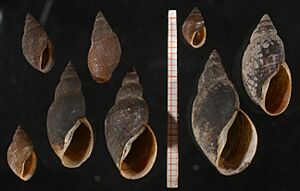Stagnicola fuscus facts for kids
Quick facts for kids Stagnicola fuscus |
|
|---|---|
 |
|
| Eight shells of Stagnicola fuscus, scale bar in mm and cm | |
| Conservation status | |
| Scientific classification | |
| Genus: |
Stagnicola (gastropod)
|
| Species: |
fuscus
|
| Synonyms | |
|
Limnaeus fuscus Pfeiffer, 1821 |
|
Stagnicola fuscus is a type of freshwater snail. It's an aquatic creature, meaning it lives in water. This snail is a gastropod mollusk, which is a group of animals that includes snails, slugs, and clams. Stagnicola fuscus belongs to the Lymnaeidae family, often called "pond snails."
Sometimes, scientists discuss the best name for this snail. Based on rules for naming animals, some experts suggest it should be called Lymnaea fusca. This is because Lymnaea was an older name for similar snails.
Contents
Where Does Stagnicola fuscus Live?
This snail is found in many parts of Europe and Asia. It lives from western Europe all the way to areas north of the Arctic Circle and across Siberia.
Countries Where You Can Find This Snail
You can find Stagnicola fuscus in several countries. These include the Czech Republic (mainly in a region called Bohemia), Germany, the Netherlands, Great Britain, Ireland, and Croatia. It's likely found in many other places too!
What Does Stagnicola fuscus Look Like?
The shell of Stagnicola fuscus is usually between 10 and 25 millimeters long. That's about the size of a small button or a little over an inch. It's also about 6 to 12 millimeters wide.
Shell Features of This Snail
- Shape: The shell is slender, meaning it's long and thin.
- Whorls: The spiral parts of the shell, called whorls, are often not very rounded.
- Sutures: The lines where the whorls join, called sutures, are almost always flat.
- Color: The shell is brown.
- Surface: It has an uneven surface with strong spiral lines. These lines cross over other lines that show how the shell grew. This can make the shell look like it has small square patterns.
- Opening: The opening of the shell, where the snail comes out, is about half the total height of the shell.
- Umbilicus: The small hole often found at the center of a snail shell is closed in Stagnicola fuscus.
Where Does This Snail Prefer to Live?
Stagnicola fuscus lives in freshwater. This means you'll find it in places like ponds, lakes, rivers, and streams. It needs a watery home to survive and thrive.


